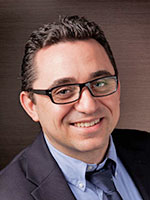Recent News
NQVL Design Phase Award
October 1, 2025
CHTM Joins NSF's NQVL Pilot Projects
August 9, 2024
OSE PHD, Dr. Xuefeng Li - Wins The Outstanding Interdisciplinary Graduate Programs Award
May 10, 2024
Dr. Ali Rastegari - 2024 OSE Best Dissertation Award Winner
May 10, 2024
News Archives
Beam shaping of Quantum Cascade Lasers offers flexible solution for high quality mid-infrared sources
March 22, 2017 - Sharon Steely

Frédéric Grillot
Simon Ferré, researcher with the Thales III-V lab, Thales Research & Technology, is the Principal Investigator for a research team that includes Louise Jumpertz and Mathieu Carras with MirSense, Centre d’intégration NanoINNOV; Robson Ferreira, with Laboratoire Pierre Aigrain, Ecole Normale Supérieure-PSL Research University; and Frédéric Grillot, Professor with Télécom ParisTech UPSaclay and Research Professor with The University of New Mexico's Center for High Technology Materials (CHTM).
The research team's paper, "Beam shaping in high-power broad-area quantum cascade lasers using optical feedback," has been published in the journal Scientific Reports, produced by Nature Publishing Group, found online here: http://www.nature.com/articles/srep44284.
Beam shaping of Quantum Cascade Lasers offers a flexible solution for high quality mid-infrared sources
Research has been ongoing in Quantum Cascade Lasers (QCLs) for the last two decades, and QCLs have become the most appealing coherent light source in the mid-infrared range. They have proven to be a stable, easily integrable, robust, efficient and powerful laser source operating at room temperature.
QCLS are used widely today in many civil and defense applications such as chemical spectroscopy, open space telecommunications, and in substance detection for materials such as explosives or drugs. Efforts to increase the power and luminance of QCLs for high precision spectroscopy and other high precision applications including selective surgery and infrared countermeasures have been strongly affected by both thermal and optical issues, producing poor quality performance.
Researchers have experimented with a variety of approaches to solve this, but they all require monolithic integration. The technologies lack flexibility and require costly additional processes such as electronic lithography or semiconductor regrowth.
In interband semiconductor broad area (BA) lasers, inducing external perturbations such as optical feedback or optical injection is an efficient technique to control the beam quality and dynamic stability without resorting to integrated solutions. Applying optical feedback enhances the beam quality by substantially reducing the filamentation, which is one of the main issues of BA laser diodes.
Filamentation corresponds to fast spatio-temporal oscillations, due to diffraction of light, self-focusing and spatial hole-burning, whose position along the laser cavity fluctuates with time. Even though the origin of filamentation is not yet fully understood, it leads to the excitation of higher spatial modes with different phase velocities, hence significantly deteriorating laser coherence and beam quality.
Optical feedback can be used to counter the filamentation-induced drawbacks, without altering other performance aspects of the laser. Compared to interband lasers, QCLs have a low linewidth enhancement factor, which does reduce the risk for filamentation. However, applying optical feedback also improves the beam quality of BA QCLs, enabling them as suitable sources for high power mid-infrared applications.
Abstract:
Broad-area quantum cascade lasers with high output powers are highly desirable sources for various applications including infrared countermeasures. However, such structures suffer from strongly deteriorated beam quality due to multimode behavior, diffraction of light and self-focusing. Quantum cascade lasers presenting high performances in terms of power and heat-load dissipation are reported and their response to a nonlinear control based on optical feedback is studied. Applying optical feedback efficiently tailors the near-field beam profile. The different cavity modes are sequentially excited by shifting the feedback mirror angle. Further control of the near-field profile is demonstrated using spatial filtering. The impact of an inhomogeneous gain as well as the influence of the cavity width are investigated.
Compared to existing technologies that are complex and costly, beam shaping with optical feedback is a more flexible solution to obtain high-quality mid-infrared sources.
The research is published in Scientific Reports:
http://www.nature.com/articles/srep44284
Scientific Reports is an online, open access journal produced by Nature Publishing Group, which publishes original research in all areas of the natural and clinical sciences. Nature.com receives an average of over 8 million unique visitors each month. Scientific Reports is indexed in ISI Web of Science, PubMed, PubMed Central, Scopus, Google Scholar and SAO/NASA ADS.


